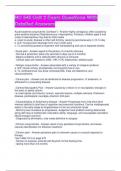Acute bacterial conjunctivitis ("pinkeye") - Answer-highly contagious; often caused by
gram-positive bacteria (Staphylococcus, Haemophilus, Proteus); children ages 6 and
under à Haemophilus may lead to otitis media
a. onset is acute; disease is often self-limiting, resolving spontaneously in 10-14 day
b. S/S: mucopurulent drainage from one or both eyes
c. Tx: preventing spread of organism with handwashing and use of separate towels;
/.Acute pain - Answer-signal to the person of a harmful stimulus
· Normal & protective; lasts only seconds to days (up to 3 months)
· Begins suddenly and is relieved after stimulus is removed.
· Clinical signs are related to ANS: ↑HR, HTN, diaphoresis, dilated pupils
/.Allergic conjunctivitis - Answer-associated with a variety of antigens (pollens)
a. S/S: Ocular itching, photophobia, burning/gritty feel in eye
b. Tx: antihistamines, low-dose corticosteroids, mast cell stabilizers, and
vasoconstrictors.
/.Cancer pain - Answer-can be attributed to disease progression, r/t treatment, or
attributed to a coexisting disease
/.Central Neuropathic Pain - Answer-caused by a lesion in or neuroplastic changes in
the brain or spinal column
i.e. brain/spinal cord trauma, tumors, vascular lesions, multiple sclerosis, Parkinson
disease, postherpetic neuralgia, phantom limb pain
/.Characteristics of Alzheimer's disease - Answer-Progresses from mild short-term
memory deficits to total loss of cognition and executive functions. Can be misdiagnosed
easily in the early stage as forgetfulness or from an emotional cause
· Memory loss increases as progresses. Judgement and problem solving deteriorate
along with loss of mathematic calculation ability, language, and visuospatial orientation.
Mood changes common.
· Diagnosis by elimination, only made definitive in autopsy.
/.Chronic conjunctivitis - Answer-result of any persistent conjunctivitis, and cause
requires identification for effective treatment.
/.Chronic pain - Answer-persistent pain of unknown cause or unusual response to
therapy
*see Table 16.4 on page 476
· Serves no purpose; extends well beyond normal healing time
· lasting more than 3-6 months
, · Thought to be related to changes in the PNS/CNS which change the way pain is
perceived and modulated
/.Chronic Post-Operative Pain - Answer-r/t disruption or cutting of sensory nerves
/.Complex Regional Pain Syndrome - Answer-associated with limb injury, surgery o
fractures. Pain is out of proportion from expected pain.
/.Deafferentation Pain - Answer-severe pain from damage to a peripheral nerve
/.Dynorphins - Answer-most potent
Binds with: kappa receptors to impede pain signals to the brain
Play a role in mood disorders, drug addiction and paradoxically in stimulating chronic
pain
/.Endogenous opiods - Answer-Neurotransmitters of pain modulation: Morphine-like
neuropeptides that inhibit transmission of pain by acting on specific opioid receptors
(mu, kappa, delta).
/.Endogenous opiods function - Answer-· They inhibit ion channels in the dorsal horn,
preventing release of excitatory neurotransmitters.
· In the midbrain, they influence descending inhibatory pathways
· In peripheral inflamed tissue, opioids are produced and released from leukocytes to
activate opioid receptors on sensory nerve terminals. They cannot cross the blood-brain
barrier - this means they do not cause CNS side effects like drowsiness, ↓respirations,
or addiction
· Found in almost all tissues in the body. In addition to analgesia, endogenous opioids
are involved in a variety of other functions in the body including modulating
stress/anxiety, feeding behavior, cough suppression, immune/inflammatory responses,
and alcohol intak
/.Endomorphins: 1 & 2 - Answer-Binds with: mu receptors in brain, brainstem, and GI
tract
/.Endorphins - Answer-produced in the brain; most studied is B-endorphin
Binds with: mu receptors in the hypothalamus & pituitary gland
Effect: greatest sense of exhilaration and substantial pain relief
/.Enkephalins - Answer-Most prevalent
Binds with: delta receptors
Concentrated in the hypothalamus, PAG matter, nucleus raphe magnus of the medulla,
and the dorsal horns of the spinal cord
/.Hemiagnosia - Answer-loss of ability to identify source of pain on one side of the body
(associated with stroke)




